Your Definitive Guide to Horse Arena Footing
Whether you are a boarding facility with multiple horses training daily, or a private backyard facility with just your horse, the process and considerations of selecting the right horse footing are the same. We have summarized the best advice available to provide you with the most important factors to optimize your horse arena footing. Whether you are going from the ground up or looking to maximize the arena you already have, this is your definitive guide to horse arena footing.
Download your own copy
Fill out the form to get your own copy of the Definitive Guide to Arena Footing.
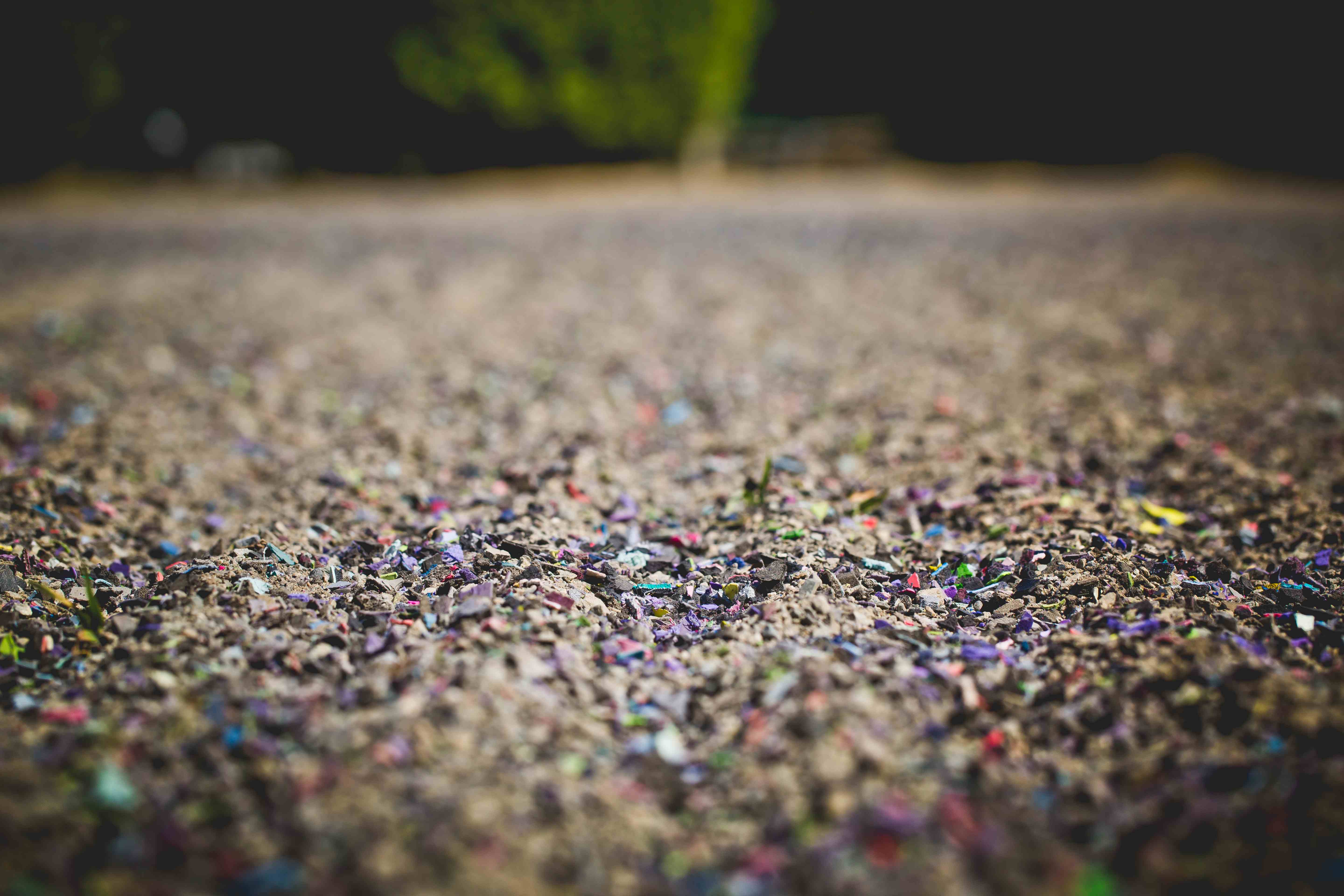
Building A Horse Arena: Footing & Other Key Considerations
Congratulations as you head down the road to building something that will give you immense satisfaction and hours of fun every week for years to come. Proper planning will prolong your investment, while allowing you to maximize the enjoyment and health of you and your horses. Most importantly, you can minimize maintenance, environmental impacts and hidden costs that can come with poor planning and construction.
Let’s take a look at the top factors you should consider when it comes to building a horse arena.
Indoor vs. Outdoor Horse Arenas
There are obvious benefits to building an indoor or an outdoor horse arena, depending on where you live and the type of riding that you intend to do.
Building an indoor arena will have added costs compared to an outdoor one, but will enable year-round riding in colder climates. If you live in a temperate climate, consider a partial indoor or covered arena, as it will give welcome relief from the sun when it’s warmer, but allows you to extend your riding season when it’s colder.
Whether you decide to construct an indoor or an outdoor horse arena, the following considerations are going to be important for selecting the ideal site for your arena:
- Slope
- Is there a natural incline that can be used as either a crown or lengthwise slope?
- Wind breaks and wind direction
- Are there natural obstacles that can be used to minimize the wind impacting the arena?
- Can the arena be oriented to minimize wind impact?
- Sun
- Are there natural obstacles to block the sun?
- Is the sun strong enough to warrant a roof?
- Drainage
- How is the natural drainage where the arena is being considered? (eg. Is there standing water?)
- Have you chosen a high point or can you choose a higher point?
- Drainage can be less of an issue with a covered arena, while an outdoor arena can become completely unusable during times of heavy rainfall.
- Consider that drainage will be the most impactful aspect of your arena so sacrifices in other areas may need to be made to maximize this.
Size and Usage Of Your Arena
To properly future proof your horse arena, you'll want to consider not only what type of riding you are doing now, but also the type you might do in future and possible resale factors. For example, though you may be doing dressage now, if you want to jump in the future, a larger ring might be a good investment.
The size requirements for different styles of riding vary widely.
Here is the typical size of a horse arena based on riding style:

Consider Your Training (and Resale) Needs
Training is another big consideration. If you board and/or train, you will need to factor in the number of horses that will be riding concurrently. A rule of thumb is 32 linear feet of railing for each horse. So, if you have ten horses training, a minimum sized arena would be 60’ by 100’.
If you intend to sell your property down the road, you may want to cater to as wide of an audience as possible; a larger arena is a good selling point. No arena owner has been disappointed with building a larger space than they think they need (if it's in the budget!).
What Makes a Good Horse Arena Base?
Our biggest piece of advice is to use a contractor who understands your needs; someone who has arena experience is ideal. Your contractor start by laying down a base on the native material and then add in layers of stone or lime dust as a sub-base. This setup allows for a good compacted layer to prevent lower materials from coming through, and further provides a solid surface for horse footing while still allowing for drainage.
A contractor's local knowledge will be key in determining the depth to which the base should be excavated down and finding the most suitable materials that will work for building the base. You don't want to skimp on material, but trucking costs can quickly add up with the multiple tons of materials that will be needed.
It's important to get the base right as the cost of fixing it afterwards is substantial with the need to pull up the footing. The base lays down the foundation (literally and figuratively) for the most important part of the arena: the footing. A solid base allows for the proper materials to perform as they were meant to. If you have a soft base or it breaks down and migrates up into the footing, you will have an unstable surface. The base is meant to be hard and consistent so that the horse encounters the exact same ride qualities no matter which part of the arena they are riding on. Softness and/or inconsistency in the base can cause the horse to work or compensate as the footing gives way in an unexpected way.
Drainage
Drainage remains one of the biggest problems for horse arena owners. It impacts your ongoing maintenance needs and your riding enjoyment - but most importantly, poor drainage leads to inconsistent footing which can pose a safety hazard to horses and riders.
There are various options to mitigate flooding issues by selecting the right type of base and/or configuration.
The location of your arena is key to this; a high elevation point is usually your best option.
Slope of your arena is another decision to be made: is a crown or a consistent slope more suitable? A slight crown with a slope of 1-1.5° to either side is ideal for run-off. A consistent slope in one direction (lengthwise) of the arena can also accomplish the same goals. Side curtains or French drains will allow the water to drain away even in parts of the country with high water tables.
If the native soil doesn't drain properly, then your expense may go up as drains will need to be installed in the sub-footing. A geotextile fabric may need to be used to protect from materials leaching into the drains, and though this will increase your arena construction expenses upfront, it will pay dividends in the long run by preventing any costly flooding issues.
A final step is to have your base layer leveled. Your contractor should have the equipment necessary to ensure your base is perfectly level and running at the right slope. Again, not ensuring that you have this base properly set at the start can cause costly issues down the road if you need to move your footing out to fix issues.
Footing
Footing is the top most important aspect of building a new arena. Having proper footing contributes to the long-term soundness and performance of the horses, riders and trainers who use the arena.
There are a variety of considerations when it comes to choosing the right footing for your arena: material availability, cushion, grip, drainage, longevity and environmental impact, to name a few. The right choice of materials will lead to years of healthy, low-maintenance, high performance for you and your horses. Keep reading on to learn everything you need to know about horse arena footing.
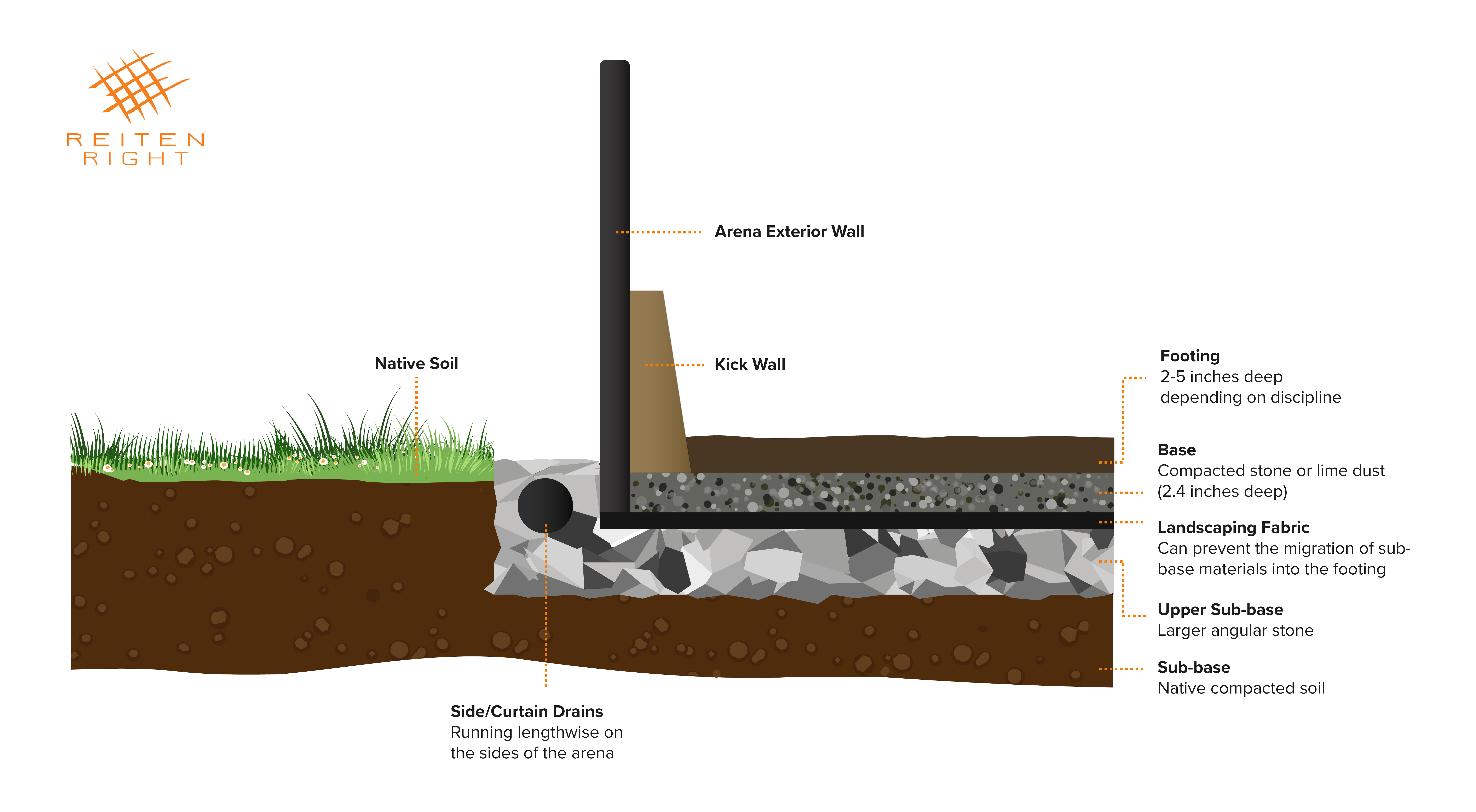
Why Is Arena Footing So Important?
Installing a state-of-the-art riding arena is a monumental moment in horse ownership. Most equestrians envision their horses performing flawlessly on a freshly dragged arena surface. The term “perfect footing” is often thrown around loosely – it means different things to riders from various disciplines. A “perfect” surface for riding should safely provide traction and cushion, not be too dusty or abrasive to the hooves, all while being easy to maintain and afford.
Footing is one of the most difficult things to calculate when it comes to building a new arena, since it’s a changing variable based on the conditions of your arena with time and use. Footing affects the overall health of your horse, the riders and trainers who use the arena, making consistency important.
Arena Footing, Soundness and Horse Performance Over Time
When selecting footing, it’s imperative to consider a horse’s health and longevity as an athlete. Equine injuries sustained during training are caused by one or more of the following combinations – a lack of fitness, over-training or poor footing. Consistent, quality footing eases the stress put on joints, muscles, bones and hooves during work. Footing that is too hard, deep, slippery or uneven increases the likelihood of an injury in the arena. Horses will perform well over a surface that has a few key factors:
- Support and Grip: How well does the surface hold up to impacts and take-offs? Does it release or roll too easily? Does it become too compacted and hard? What factors make it go to either extreme (e.g. dryness, wetness)?
- Cushion: How much cushion is provided by the footing that doesn’t sacrifice support too much? This is one of the key factors in preventing soft-tissue injuries over time.
- Consistency: Uniformity of surface is also important so that a horse is both training on the same surface from day to day as well as throughout the arena.
- Energy Return: This is very closely related to cushion and support. Does the surface have “spring” to it that can give energy back to the horse?
Arena Footing 101
The key to maintaining a successful arena is understanding how components work individually and as a team. Most arena footing is a blend of two or more materials with excellent drainage properties. Awareness of how the environment will affect materials over time is essential for creating a proper maintenance program. Even a pristine management plan cannot prevent certain materials, like sand from breaking down or compacting as the years go by.
Components of Horse Arena Footing
A well-manicured riding space goes beyond the surface. The main arena components include the footing, base and sub-base.
- Footing: Footing is the visible top layer, which is the most important. Footing is a loose component about 2 – 6 inches thick, based on the discipline(s) of the riders.
- Base: The footing sits on top of the base, a level and solid compact surface that drains well. The loose footing cannot slide freely on top of the base as the horses work. The successful marriage of the footing and the base can occur naturally when the proper materials are selected or through a professional installation from a contractor.
- Sub-base: The sub-base is the third element of the arena. The compacted surface is created using natural soil from the land to form a build-up pad. Generally the sub-base and base are separated with landscaping fabric.
Common Arena Footing Materials
The geographical region of a horse property often determines the materials used based on availability and access. Common arena footing materials include sand, wood, stonedust and rubber.
Sand
Sand is the most familiar widely accepted arena footing. It’s readily available and has an attractive price point. It can be used alone or mixed with an additive to enhance it. Sand dries out quickly and is known for becoming quite dusty, needing frequent waterings. Damp sand offers better traction, but can also drive up a water bill.
There are many different types of sand that can be broken down by:
- Sphericity: How round is the sand? The more round a sand is it more it will tend to move around and against other grains of sand.
- Angularity: How sharp are the edges to the sand? Higher angularity will allow the individual grains to bind with each other and reduce “shiftiness”.
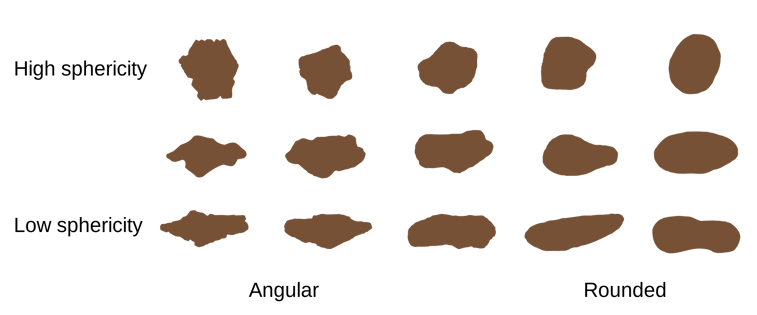
(By Woudloper - Own work, Public Domain, https://commons.wikimedia.org/w/index.php?curid=6368983)
- Grain Size: A sieve analysis by a knowledgeable professional can help determine the right distribution of grain size. An over-propensity of larger or consistent grain sizes will tend to drain well but may roll and/or not bind well. A large amount of smaller grain sizes (sometimes referred to as silt or clay) may cause excessive compaction, binding and/or dustiness, depending on the amount of water used.
Here is an example of a sieve analysis for different types of sand:
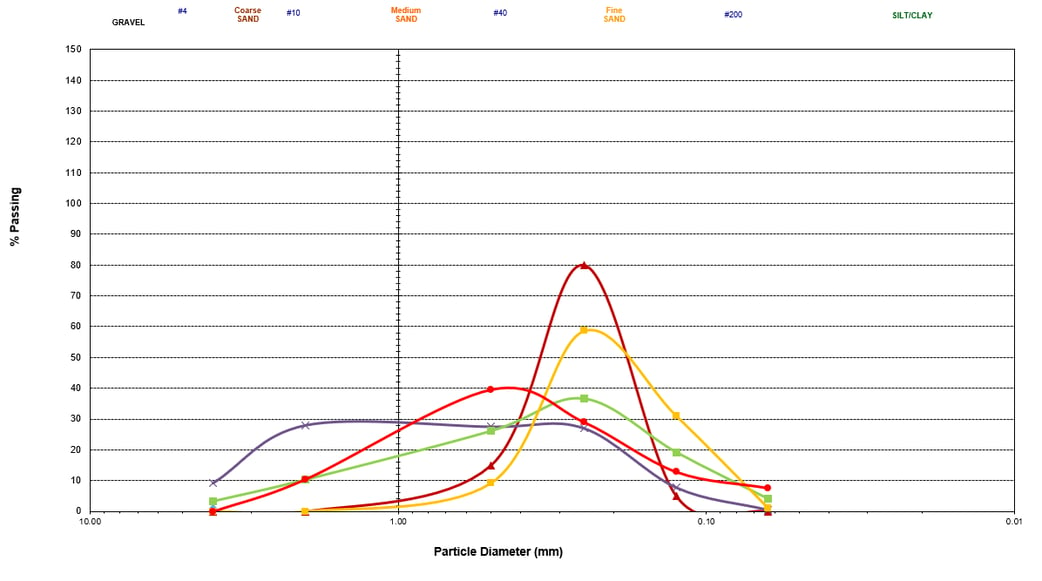
Having a balance of the right sphericity and angularity is important and particular to the conditions and additives that may be used.
Caution should be exercised when sourcing sand by name as different regions will have similar terms for sand that may have widely different compositions. Again a proper sieve analysis is key to sourcing the right product.
Download and review our comprehensive Horse Arena Sand Guide to learn more.
Or if you'd like to have a sand analysis to determine what type of sand you have, why you might having issues or what the best solutions are, our operations team would be happy to help.
Wood
Wood chips are used as a standalone footing or mixed with other materials; for example, coarse sawdust can be combined with sand. Wood as a footing material offers cushioning, locks in moisture and can have good binding when composed of the right type of wood and moisture. It is also a more cost-effective alternative.
However, there are two main downsides of wood:
- Availability, as it can vary by region; and
- It can break down quickly; depending on the volume of use in the arena, wood chips will become smaller in a comparatively short amount of time and need to be replaced.
For safety purposes, if you plan on using wood footing, it is recommended to purchase from a manufacturer that specializes in horse arena footing. Be sure to avoid walnut and black cherry products as they are extremely toxic to horses.
Stonedust
Decomposed granite, white stone, limestone screenings and blue stone are classified as stonedust. The low price point of stonedust makes it an attractive footing source, but it does need meticulous care. It’s easier to maintain when mixed with rubber to aid in retaining moisture and avoiding compaction. Stonedust drains well and is a stable footing, but it requires frequent waterings. Once it dries out, it can compact and become very hard.
Arena Footing Additives: What Are They?
Arena footing additives are materials designed to enhance and complement different types of new and existing arena footing. Additives include rubber fragments, oils, salt mixtures and various fiber textiles. Scientists, veterinarians and equestrians, have been carefully studying the effects of the additives. They have found that when mixed with sand or other footing, the additives can help stabilize the footing, absorb shock from the hoof and control moisture. The additives are installed by evenly spreading them throughout the existing footing.
Let’s take a look at the most common arena footing additives and how they fare against one another.
Fiber / Felt
This is a widely used arena footing additive consisting of a number of different types, shapes and lengths of material. A typical fiber blend may have smaller fiber strands mixed with a felt that allows sand to bind to it. Acting like sandpaper, this allows the sand to bind and provide a more stable surface.
The benefits of fiber are mainly around its binding properties and ability to give a stable and compact base to the horse. These properties are mainly sought out by those seeking the optimal performance from their horse.
The risks or downsides to fiber are:
- Those same performance benefits that the horse will see from a stable or compact surface can, over time, lead to issues as the surface becomes too sticky or compact and concussive forces lead to soft tissue injuries.
- The products are made of a variety of materials that have been either recycled (e.g. carpet) or more typically, produced from plastic or polypropylene (e.g. the same material as plastic straws). The environmental impacts of this are starting to be questioned.
Rubber
Rubber is known for its wonderful elastic properties. It offers cushioning for the hooves, and always “bounces back.” Rubber adds stability to sand and mixes beautifully with sand or stonedust to reduce compaction. Care should be taken to ensure the rubber footing additive is free from foreign materials or shards of metal.
Additionally, horse arena owners should be aware that there are a few types of rubber that have different properties environmentally, elastically and dynamically within the footing. Let’s take a closer look at each type of rubber:
Open-Celled vs. Closed-Cell Rubber
These two types of rubber will, as the name implies, have many open cells throughout the material or not. The open-celled variety will allow for moisture retention, extra cushion and will not freeze in extreme cold. A closed cell rubber will also tend to float and migrate to the sides of the footing or sit near the surface and be impacted more by the elements.
EVA (or EVA Foam or EVA Rubber)
This is a frequently used substance in products like shoe soles, boxing gloves, hockey pads and products that need buoyancy like floating eyewear. Also closed-cell, this type of rubber that had been found in the Nike running shoes additive (shredded Nike runners) fell out of vogue because of the inconsistency of the material within.
Tire or “Crumb” Rubber
As the name states, this is shredded tire rubber. This is a cheaper alternative in the rubber space with a few large downsides.
- As a closed cell rubber it will float and eventually migrate out the sides and drains of the arena. Large buildup of the product in the sides and around drains is a regular occurrence.
- It will freeze in colder temperatures causing the opposite of the cushioning effect that is being sought.
- It is composed of many materials other than rubber that are known to be toxic or carcinogenic. As it breaks down with use it can become airborne and coat the arena or be inhaled.
Magnesium Chloride
Magnesium chloride a well-recognized arena footing additive to help reduce dust. Caution should be taken in sourcing the right products or dry hoofs and/or respiratory issues can result. It is a suitable product for indoor arenas or areas with little rain as the product will wash away very quickly.
Magnesium chloride should not be a solution for sand that may have reached the end of its life. If sand has become dusty, it may be that the particles are too fine, which may mean it is time for it to be replaced.
Arena Footing Additives Comparison
Below is a summary and comparison of the different types of arena footing additives we discussed.
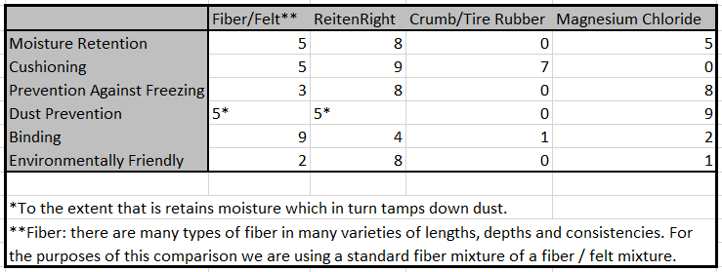
If you intend to use your equestrian sand with a footing additive, we suggest requesting a sample so you can make an informed decision. To give ReitenRight’s premium footing additive a try, complete this form to request a free sample.
how can we help you?
As you can see, there are a lot of factors to consider when it comes to horse arena footing and additives. Understanding these factors, along with the unique needs of your arena, will allow you to formulate the best footing blend that enables your horses and riders to ride their best.
ReitenRight has been used by professional equestrians and state-of-the-art horse arenas across North America. We’ve researched and tested our product extensively over the last five years to create impressive results, raising the bar for horse footing additives.
Get in touch with us today to discuss how we can take your arena performance to the next level.


